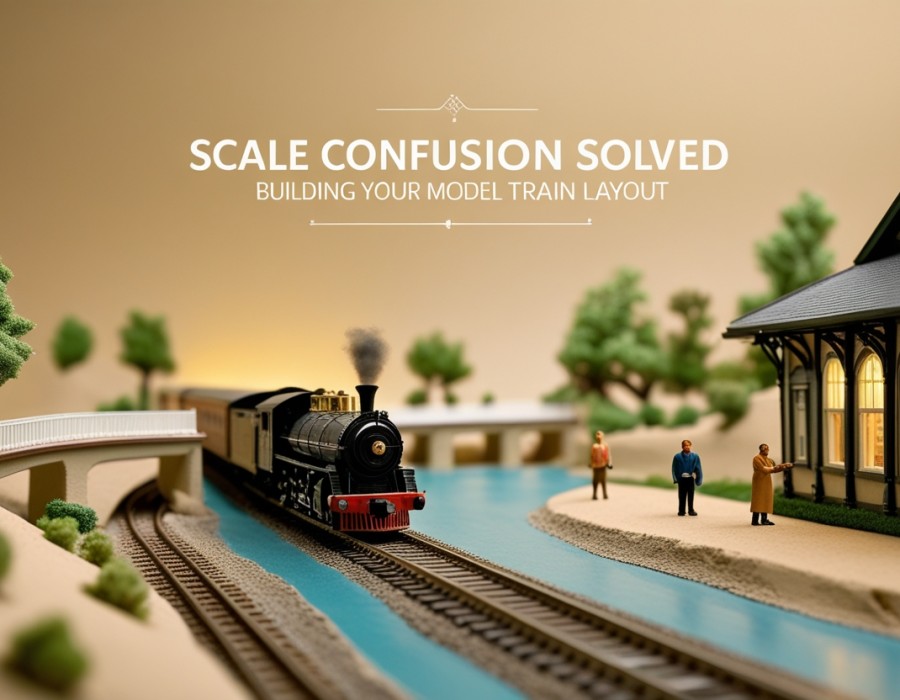Creating a model train layout is a super rewarding hobby that blends creativity, craftsmanship, and an interest in trains. But one of the main challenges hobbyists, especially in the beginning, face is scale confusion. Scale is important to understand and manage because everything about how your layout fits together relies on scale, from the number of tracks, size of the scenery, and the right rolling stock.
In this blog, we will dive deep into how to avoid scale confusion when building your model train layout. You’ll learn what scale means, why it matters, and how to pick the right scale for your project. We’ll also discuss how to maintain consistency and avoid costly mistakes, so your model train layout looks authentic and functions smoothly.
What Does Scale Mean in Model Trains?
Before delving into scale confusion, it is important to understand what scale is when referencing model trains.
Scale refers to the ratio of the size of the model to that of the actual train that the model is designed to represent. If a model is built in a 1:87 scale, then the model is 87 times smaller than the actual train. This analogy ensures model trains (and tracks, buildings, scenery, etc.) are relative to one another.
Some of the most popular scales include:
HO scale (1:87): The most popular, great for first-time modelers and hobbyists with reasonable space.
N scale (1:160): Smaller than HO, best for people with limited space.
O scale (1:48): Larger than HO, which is more attractive for realistic detail but requires more space.
Z scale (1:220): Very small, for those who want to fit complex layouts in tight areas.
Why Scale Confusion Happens and Its Impact
Scale confusion occurs when hobbyists mix components of different scales or misunderstand what scale fits their space and goals. This confusion can lead to mismatched components, such as trains, tracks, and scenery that do not align properly, which ruins the realism of the layout. It can cause track fitting problems since tracks from different scales will not connect properly. It may also lead to space miscalculations if a scale too large or too small is picked for the available layout space. Additionally, scale confusion can increase costs by requiring replacement or modification of parts that don’t fit.
Avoiding these issues ensures your model train layout looks realistic and functions smoothly.
Steps to Avoid Scale Confusion in Your Model Train Layout
1. Research Before Buying
Before purchasing any trains, tracks, or accessories, do thorough research. Understand the popular scales, their pros and cons, and what works best for your available space. Join online forums, read blogs, and watch videos from experienced modelers to gather valuable insights.
2. Choose a Single Scale for Your Layout
The simplest way to avoid confusion is to pick one scale and stick with it. While mixing scales within a single layout can be done intentionally for artistic reasons, it is tricky and usually not recommended for beginners.
3. Consider Your Space Constraints
Your available space plays a huge role in scale selection. For example, if you have a small apartment, an N scale might be ideal. A large basement or garage might accommodate HO or O scale better. Measure your space carefully and envision your layout’s footprint before making a decision.
4. Understand Track Gauges and Compatibility
Track gauge refers to the distance between the rails and varies by scale. Ensure your tracks and trains are compatible. Mixing incompatible gauges causes operational issues and can damage your models.
5. Buy from Trusted Brands and Sources
Purchasing from reputable manufacturers or sellers guarantees scale-accurate models. This consistency reduces the risk of scale mismatches.
6. Keep All Your Scale Information Handy
Label your boxes, make notes, or keep a digital record of your scale information for each piece of equipment. This habit helps avoid accidental mixing during layout expansions or upgrades.
Common Scale Mistakes and How to Fix Them
Even with careful planning, mistakes happen. Here are some common scale-related issues and how to fix them.
Mixing HO and N scale trains can be problematic. If you want to run multiple scales, consider separate layouts or modular sections instead of combining them on one layout.
Using the wrong track gauge will prevent trains from running smoothly. The best fix is to replace the incompatible track with the correct gauge.
If the scenery appears too large or too small, adjust your scenery elements or add transitional-scale objects such as human figures or buildings designed to bridge scale differences.
Maadhu Train Miniatures Is the Best for Train Miniature Models for Your Choice in 2025
When building your model train layout, having quality and scale-accurate miniatures is key. Maadhu Train Miniatures stands out as the best choice for 2025 due to their wide selection of meticulously crafted train models and accessories that cater to various scales, especially HO and N.
What makes Maadhu Train Miniatures unique?
They ensure precision scale accuracy, with each model designed to exact scale specifications. Their wide range of options covers everything from locomotives to freight cars and detailed scenery. Their miniatures strike the perfect balance between durability and fine detailing, making them ideal for beginners and seasoned hobbyists alike. On top of that, their excellent customer support helps you choose the right scale and accessories for your project.
Choosing Maadhu Train Miniatures helps eliminate scale confusion and gives you peace of mind about the quality and compatibility of your layout pieces.
Tips for Maintaining Scale Consistency Over Time
Once you’ve chosen your scale and started building, maintain consistency by regularly verifying scale information before buying new items. Keep your layout organized with labeled storage and document any changes or expansions to your layout. Joining scale-specific hobby groups can also provide ongoing advice and support.
Conclusion
When building your model train layout, avoiding scale confusion is essential for creating a cohesive, realistic, and enjoyable hobby experience. By understanding what scale means, researching your options, choosing one scale, and buying from trusted brands like Maadhu Train Miniatures, you set yourself up for success.
Remember that scale is the foundation of your entire model train world. Getting it right at the beginning will save frustration and expense later, allowing your creativity to shine through in a beautifully coordinated layout.
FAQs
Q1: Can I mix different scales on the same model train layout?
It’s generally not recommended because it disrupts realism and can cause operational issues. If you want to mix scales, consider separate sections or modular layouts.
Q2: What scale is best for beginners with limited space?
N scale is ideal for limited space as it is smaller than HO but offers good detail and track options.
Q3: How do I know if a train model is true to scale?
Buying from reputable manufacturers like Maadhu Train Miniatures ensures models adhere to precise scale specifications.






Comments